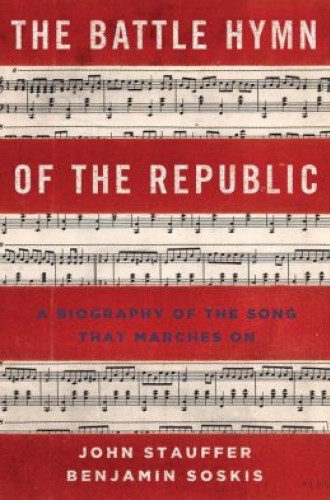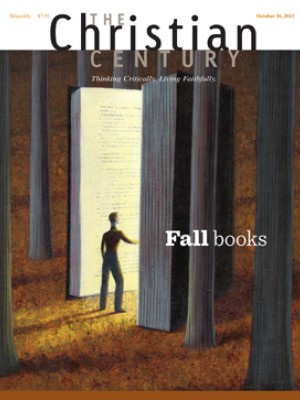The Battle Hymn of the Republic, by John Stauffer and Benjamin Soskis
How did Julia Ward Howe’s pro–federal Union and abolitionist-inspired “Battle Hymn of the Republic” become the most recognizable American anthem of the 20th century? Why is it embraced by liberals and conservatives, radicals and businesspeople, whites, blacks and beyond? The story of the song, detailed exquisitely in this book by John Stauffer and Benjamin Soskis—respectively an esteemed professor of American history at Harvard and a newly minted Ph.D. from Columbia University—is more than a fascinating picture of the United States from the 19th century to the present. The book contains a multitude of stories that feature biracial friendships, social dramas and political intrigues. The whole tale is suffused with religious fervor. If you want to hear the harmonies within American civil religion as they sounded throughout American history, grab The Battle Hymn of the Republic and prepare to be moved.
The origins of the “Battle Hymn” are as fabulously twisted as the world of the antebellum United States. Its seeds were sown in the biracial evangelical awakenings of the American South. Revival fires had swept through the nation in the decades after the American Revolution, and from them a new song emerged, “Grace Reviving the Soul.” More commonly known as “Say Brothers,” it could be heard from the forests of Tennessee to the sea islands of South Carolina and in the Gullah dialects of slaves. The song migrated north into hymnbooks, but then it took an unexpected turn in the late 1850s, when John Brown changed America and a new song changed him.
Read our latest issue or browse back issues.
After decades as a failed businessperson and an abolitionist zealot, Brown led a small group of African Americans and whites to capture the federal arsenal at Harpers Ferry, Virginia, in October 1859. The plan was to distribute arms, munitions and pikes to the hundreds or thousands of slaves who would flock to the uprising. They never showed. Brown’s group was defeated, and he was imprisoned. Several months later, he was executed. His physical body was buried. Another one was created in song and trotted out to war.
The various versions of “John Brown’s Body” rang through Civil War America and infuriated southern whites. Union soldiers adapted the tune and structure of “Say Brothers” to joke, to pass time and to inspire righteous rage; Brown became a “soldier in the army of our Lord,” and northern soldiers would one day see “Jeff Davis hang from a sour apple tree.” Although military men loved the tune, more refined Americans—like Boston reformer Julia Ward Howe—hoped for something less brutish. So Howe composed the song that keeps marching on. Today it can be heard from the camps of George W. Bush to those of Barack Obama, from neo-Klan rallies to civil rights commemorations.
Howe supposedly wrote “The Battle Hymn of the Republic” during the wee hours of one morning in November 1861. Her goal, as Stauffer and Soskis recount it, was to pour the sacred sentiments of “John Brown’s Body” into a more dignified wineskin. The result was a depersonalized, apocalyptic and millennial rendering of war for God’s sake that more effectively carried the bloody, prophetic qualities of Brown’s spirit. Where others may have seen disease and diarrhea, Howe found “the glory / Of the coming of the Lord.” Where others saw death and destruction, she witnessed “a fiery gospel / Writ in burnish’d rows of steel.” In hellish violence, she beheld holy victory.
After the Civil War, “John Brown’s Body” and the “Battle Hymn” existed in tension. The former clearly invoked the abolitionist cause, and its vindictive bent hindered sectional reconciliation. The latter seemed more malleable; like the words of the Bible, the apocalyptic language of the “Battle Hymn” was adaptable for just about every position. For most of the rest of the 19th century, southern whites found both songs offensive.
By the late 1890s, however, northern and southern whites had stopped shooting at one another and instead had turned their weapons on a new foe: the Spanish Empire and its colonies in Cuba, the Philippines and elsewhere. In the jingoist days of the wars of 1898, the “Battle Hymn” inched toward becoming an American anthem. Of course, anti-imperialists like Mark Twain viewed it as another sick expression of the pro-American pseudo-religion that masqueraded as genuine Christianity. Twain wrote and kept private an “updated” version of the song in which his eyes had seen “the orgy of the launching of the Sword” and had read “the bandit gospel writ in burnished rows of steel.”
Throughout the 20th century the “Battle Hymn” had a dual role. It bonded Americans with a musical rendering of their civil religion, and it distilled profound class and racial conflicts in the nation. Labor radicals, for instance, believed that the song had been co-opted and corrupted by conservatives in the first decades of the century. In response, they revised the “Battle Hymn” into “Solidarity Forever,” transforming the pro-national Union song into a pro–working class anthem. They removed references to God and crafted the work and suffering of laborers into a hymn of human agency.
At the same time, white evangelicals worked the song into their repertoire. Even though fundamentalist J. Gresham Machen disliked the “Battle Hymn” because he found it a culturally specific approach to the timeless gospel, revivalists Billy Sunday and Billy Graham used the anthem regularly. Howe’s song was a nice fit for their pro-American Protestant Christianity, especially in times of hot and cold war.
Many chapters in The Battle Hymn of the Republic consist of short biographies, with social trends and other examples framing the personal stories. For example, the tale of labor radicalism and the making of “Solidarity Forever” focuses primarily on writer and activist Ralph Chaplin, and the story of the “Battle Hymn” being forged into an evangelical staple revolves around the ministries of Sunday and Graham. The deployment of the song by African Americans is recounted largely through the biography of Martin Luther King Jr., and its embrace by political conservatives is exemplified by Ronald Reagan. The biographical emphasis has a wonderful effect. In narrating the creation and reworking of the songs, Stauffer and Soskis present dramatic and personal renderings of how individual sensibilities have influenced and been influenced by broader historical trajectories.
Stauffer and Soskis’s study breathes new life into Civil War scholarship. It runs against the grain of two recent trends. First, by highlighting interactions and intersections of white and black Americans, it refuses to focus on one group to the diminishment of another. Second, by emphasizing meanings made during the Civil War through music and performance, Stauffer and Soskis embrace the life-making efforts of the day, whereas many scholars have followed Drew Gilpin Faust’s This Republic of Suffering and emphasized death as the animating force of the Civil War era. It was certainly an era of destruction, but it was also a time of new life in the form of new cultural anthems like Howe’s hymn, as well as in the form of emancipation.
The Battle Hymn of the Republic is beautifully rendered history. Full of surprising twists and turns, it should be on the shelf of everyone who has sung the song.
This article was corrected on October 9, 2013.






